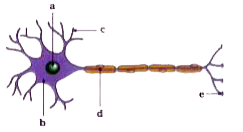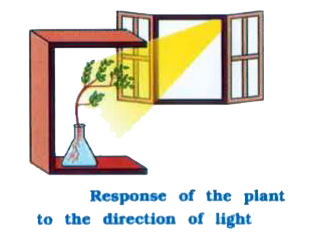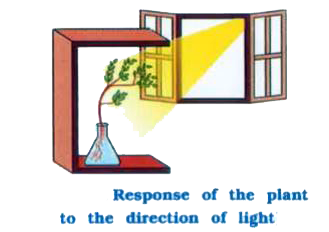Complete Solutions to QUESTIONS AND ANSWERS of chapter CONTROL AND COORDINATION of Class 10 book with complete answers and questions
| Class 10 | BIOLOGY |
| Chapter | CONTROL AND COORDINATION |
| KUMAR PRAKASHAN | QUESTIONS AND ANSWERS |
| Number Of Questions | 53 |
| Academic Year | 2023-24 |
What is a movement ? What are the different purposes for which movements are seen in organisms ? Give suitable examples.
View SolutionWhy are there controlled movements in living organisms ?
View SolutionHow do hot object stimulates reflex action?
View SolutionWhat are receptors ? State the example, location and function of different receptors in human body.
View SolutionExplain how nervous impulses travel in the body.
View SolutionIdentify the parts of a neuron in a diagram :
(1) where information is acquired,
(2) through which information travels as electrical impulse, and
(3) where this impulse in must be converted into a chemical signal for onward transmission.

View SolutionTo detect the taste bud (gustatory receptor) and its function.
`rarr` Put some sugar on your tongue in the mouth.
`rarr` Block your nose by pressing it between your thumb and index finger.
`rarr` Now eat sugar again.
`rarr` While eating lunch, block your nose in the same way and notice if you can fully appreciate the taste of food you are eating.
How does the sugar taste ?
View SolutionTo detect the taste bud (gustatory receptor) and its function.
`rarr` Put some sugar on your tongue in the mouth.
`rarr` Block your nose by pressing it between your thumb and index finger.
`rarr` Now eat sugar again.
`rarr` While eating lunch, block your nose in the same way and notice if you can fully appreciate the taste of food you are eating.
Is there any difference in the taste of sugar while you block your nose ?
View SolutionTo detect the taste bud (gustatory receptor) and its function.
`rarr` Put some sugar on your tongue in the mouth.
`rarr` Block your nose by pressing it between your thumb and index finger.
`rarr` Now eat sugar again.
`rarr` While eating lunch, block your nose in the same way and notice if you can fully appreciate the taste of food you are eating.
Is there a difference in how sugar and food taste if your nose is blocked ? If so, why might be happening ?
View SolutionTo detect the taste bud (gustatory receptor) and its function.
`rarr` Put some sugar on your tongue in the mouth.
`rarr` Block your nose by pressing it between your thumb and index finger.
`rarr` Now eat sugar again.
`rarr` While eating lunch, block your nose in the same way and notice if you can fully appreciate the taste of food you are eating.
Do you come across a similar situation when you have a cold ?
View SolutionWhat is the meaning of reflex actions ? Give examples.
View SolutionExplain why we give slow response compared to reflex in any activity involved thinking.
View SolutionExplain reflex arc. Explain spinal reflex.
View SolutionExplain how is hand pulled away from the hot object reflexly.
View SolutionWhy reflex arcs have been evolved in animals ? Explain.
View SolutionHow does the design of the body solve a problem when immediate response is needed ?
View SolutionState the organization of human nervous system and general functions of it.
View SolutionDescribe human brain with specific functions of its different parts.
View SolutionExplain : Human brain
View SolutionHow central nervous system protected?
View SolutionWhat are the functions of nervous tissue ? How muscle tissue respond to nervous impulses ?
View SolutionWrite short notes : (1) Fore-brain (2) Movement of voluntary muscles
View SolutionWhat is the difference between a reflex action and walking ?
View SolutionWhat happens at the synapse between two neurons ?
View SolutionWhich part of the brain maintains posture and equilibrium of the body ?
View SolutionHow do we detect the smell of an agarbatti (incense stick) ?
View SolutionWhat is the role of the brain in reflex action ?
View SolutionState the types of movement in plants with examples.
View SolutionHow does the sensitive plant detect the touch and how do the leaves move in response ?
View SolutionHow is coordination in plants different from coordination in animals ?
View SolutionExplain the movement in pea plant due to growth.
View SolutionTo observe the response of plant parts to light OR To study phototropism in plants.
Materials : Conical flask, wire mesh, cardboard box open from one side, water, two- three freshly germinated bean seeds.
Procedure :
`rarr` Fill a conical flask with water.
`rarr` Cover the neck of the flask with a wire mesh.
`rarr` Keep two-three freshly germinated bean seeds on the wire mesh.
`rarr` Take a cardboard box which is open from one side.
`rarr` Keep the flask in the box in such a manner that the open side of the box faces light coming from a window.
`rarr` Observe after two or three days and note down your observation.
`rarr` Now turn the flask and leave it undisturbed in this condition for a few days and then observe.

Observation : In the initial position of flask, the shoot bends towards light and roots turn away from light.
`rarr` After turning the flask, position of shoot and roots change, i.e., shoot goes away from light and roots turn towards light but after a few days shoot again shows bending towards light and roots move away from light.
Have the old parts of the shoot and root changed direction ?
View SolutionTo observe the response of plant parts to light OR To study phototropism in plants.
Materials : Conical flask, wire mesh, cardboard box open from one side, water, two- three freshly germinated bean seeds.
Procedure :
`rarr` Fill a conical flask with water.
`rarr` Cover the neck of the flask with a wire mesh.
`rarr` Keep two-three freshly germinated bean seeds on the wire mesh.
`rarr` Take a cardboard box which is open from one side.
`rarr` Keep the flask in the box in such a manner that the open side of the box faces light coming from a window.
`rarr` Observe after two or three days and note down your observation.
`rarr` Now turn the flask and leave it undisturbed in this condition for a few days and then observe.

Observation : In the initial position of flask, the shoot bends towards light and roots turn away from light.
`rarr` After turning the flask, position of shoot and roots change, i.e., shoot goes away from light and roots turn towards light but after a few days shoot again shows bending towards light and roots move away from light.
Are there differences in the direction of the new growth ?
View SolutionTo observe the response of plant parts to light OR To study phototropism in plants.
Materials : Conical flask, wire mesh, cardboard box open from one side, water, two- three freshly germinated bean seeds.
Procedure :
`rarr` Fill a conical flask with water.
`rarr` Cover the neck of the flask with a wire mesh.
`rarr` Keep two-three freshly germinated bean seeds on the wire mesh.
`rarr` Take a cardboard box which is open from one side.
`rarr` Keep the flask in the box in such a manner that the open side of the box faces light coming from a window.
`rarr` Observe after two or three days and note down your observation.
`rarr` Now turn the flask and leave it undisturbed in this condition for a few days and then observe.

Observation : In the initial position of flask, the shoot bends towards light and roots turn away from light.
`rarr` After turning the flask, position of shoot and roots change, i.e., shoot goes away from light and roots turn towards light but after a few days shoot again shows bending towards light and roots move away from light.
What can we conclude from this activity ?
View SolutionWhat is meant by 'Tropisms'? Explain with an example.
View SolutionExplain the statement : Electrical impulses are an excellent means for coordination with its own limitations.
View SolutionExplain in short : Chemical communication or hormonal coordination.
View SolutionDescribe plant hormones.
View SolutionState the names of plant hormones and their effects.
View SolutionWhat are plant hormones ?
View SolutionHow is the movement of leaves of the sensitive plant different from the movement of a shoot towards light ?
View SolutionGive an example of a plant hormone that promotes growth.
View SolutionHow do auxins promote the growth of a tendril around a support ?
View SolutionDesign an experiment to demonstrate hydrotropism.
View SolutionWhich hormone is secreted under the fight or flight situation ? State its effects.
View SolutionState the properties of animal hormones.
View SolutionExplain hormones related with growth in human.
View SolutionExplain disorders caused by hormonal imbalance in human beings.
View SolutionExplain feedback mechanism regulation of hormone secretion.
View SolutionHow does chemical coordination take place in animals ?
View SolutionWhy is the use of iodised salt advisable ?
View SolutionHow does our body respond when adrenaline is secreted into the blood ?
View SolutionWhy are some patients of diabetes treated by giving injections of insulin ?
View Solution
QUESTIONS AND ANSWERS questions and complete solutions for chapter CONTROL AND COORDINATION of KUMAR PRAKASHAN of Class 10
All Exercises from KUMAR PRAKASHAN Class 10 BIOLOGY CONTROL AND COORDINATION
- ADDITIONAL QUESTIONS AND ANSWERS
- OBJECTIVE QUESTIONS AND ANSWERS
- OBJECTIVE QUESTIONS AND ANSWERS (Answer as directed : (Miscellaneous))
- OBJECTIVE QUESTIONS AND ANSWERS (Answer the following questions in short : )
- OBJECTIVE QUESTIONS AND ANSWERS (Define : OR Explain the terms : )
- OBJECTIVE QUESTIONS AND ANSWERS (Fill in the blanks : )
- OBJECTIVE QUESTIONS AND ANSWERS (Select the correct alternative from those given below each question : )
- OBJECTIVE QUESTIONS AND ANSWERS (State whether the following statements are true or false: )
- OBJECTIVE QUESTIONS AND ANSWERS(Chart-diagram based questions: )
- PRACTICAL SKILL BASED QUESTIONS WITH ANSWERS
- QUESTIONS AND ANSWERS
- TEXTUAL EXERCISE
- VALUE BASED QUESTIONS WITH ANSWERS